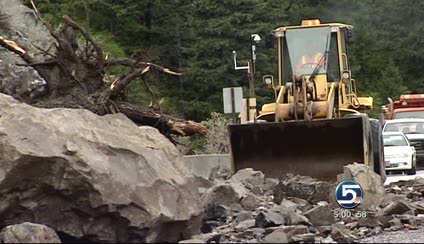Estimated read time: 2-3 minutes
This archived news story is available only for your personal, non-commercial use. Information in the story may be outdated or superseded by additional information. Reading or replaying the story in its archived form does not constitute a republication of the story.
SALT LAKE CITY — The recent rains have caused more than a fear of flooding, as canyon hillsides are threatening to collapse and roads are being covered with mud.
"We've had this continuous rainfall that really started back in October," said Jeff Niermeyer, Salt Lake City Public Utilities director. "It has just rained and rained and there's no place for the water to go."
These rocks are very large. We have some that are about the size of a small car. Some are in the 200-pound range.
–Vic Saunders, UDOT
The hillside at the mouth of City Creek Canyon, he said, has been sliding under increased water pressure since 1937, but has already moved 8 feet this spring with all the recent moisture.
"It starts to saturate the upper surface of the groundwater and what that does is basically relieve the inner pressure between the soil particles and creates the potential for landslides," Niermeyer said.
Excess water sent an estimated 200,000 tons of rocks and mud onto state Route 39 Thursday evening, damaging at least two cars and closing the road on the southern shores of Pineview Reservoir for most of the day. Utah Department of Transportation engineer Brent DeYoung said the hillside had been stabilized, but more rain could change that.
"We're still seeing some risk," he said. "We're still seeing some movement on the slope."
The area can be problematic for rock slides because of the sheer slopes that abut the highway.
Related:
UDOT spokesman Vic Saunders said, "These rocks are very large. We have some that are about the size of a small car. Some are in the 200-pound range."
Saturated soils across the state have communities and emergency services managers on heightened alert because of the increased likelihood of mudslides.
Some movement in historically troublesome areas such as Mountain Green and City Creek has already been detected.
Niermeyer said Salt Lake City works closely with the Utah Geologic Society to keep an eye on shifting ground. The group provides technical advice based on the history of the hillsides it monitors, which helps to know what to do in the future.
After a large mudslide filled backyards and streets in Draper last year, city crews have built rock channels to divert whatever might come down if the saturated soil in the wildfire-ravaged area breaks loose.
"We have pallets of sandbags ready to go," said city spokeswoman Maridene Hancock. "We've been very proactive."
Officials are hopeful that the return to warmer temperatures that is expected this weekend, will help dry out the rain-filled soils.
-----
Written with contributions from Amy Joi O'Donoghue and Jed Boal.









